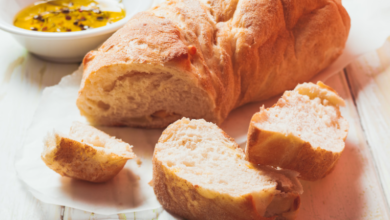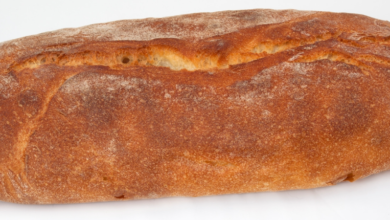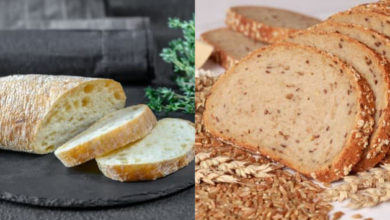The History, The Texture, The Taste – What Is Ciabatta Bread?
What To Know
- Store ciabatta bread in a bread bag at room temperature for up to 2 days.
- Ciabatta bread can be used as a base for baked dishes, such as pizzas and bread pudding.
- Ciabatta bread has a more open crumb and a chewier texture than French bread.
Ciabatta bread, with its distinctive open crumb and crispy crust, has become a staple in the culinary world. But what exactly is ciabatta bread? This blog post will delve into the history, characteristics, and versatility of this beloved Italian bread.
History of Ciabatta Bread
Ciabatta bread originated in the Veneto region of Italy in the 1980s. It was created as a response to the increasing popularity of French baguettes. Italian bakers sought to develop a bread that would rival the baguette’s lightness and crispiness while maintaining a distinct Italian character.
Characteristics of Ciabatta Bread
Ciabatta bread is characterized by its:
- Large, irregular holes: The dough is wet and undergoes a long fermentation process, resulting in large, open crumb holes.
- Crispy crust: The dough is baked at a high temperature, creating a golden-brown, crusty exterior.
- Chewy texture: Despite its large holes, ciabatta bread has a chewy texture due to its high hydration.
- Mild flavor: Ciabatta bread has a mild, slightly sour flavor that complements a wide range of dishes.
Ingredients and Process
Ciabatta bread is made with simple ingredients:
- Flour: High-protein flour is used to create the gluten network that gives the bread its structure.
- Water: A high water content (up to 80%) creates the wet dough and open crumb structure.
- Salt: Salt enhances the flavor and helps control fermentation.
- Yeast: Yeast is responsible for the fermentation process that produces the characteristic holes.
The dough is mixed and allowed to ferment for a long period, typically overnight. It is then shaped and baked in a hot oven.
Versatility of Ciabatta Bread
Ciabatta bread’s versatility makes it a favorite among chefs and home cooks alike. It can be used for:
- Sandwiches: The large holes and chewy texture make it an ideal bread for hearty sandwiches.
- Panini: Ciabatta bread is a classic choice for toasted panini with melted cheese and grilled meats.
- Bruschetta: Sliced ciabatta bread is toasted and topped with various ingredients for a simple and flavorful appetizer.
- Dipping: Ciabatta bread’s crispy crust and mild flavor make it perfect for dipping into soups, stews, and sauces.
Nutritional Value
Ciabatta bread is a good source of:
- Carbohydrates: Provides energy for the body.
- Protein: Helps build and repair tissues.
- Fiber: Aids in digestion and promotes a feeling of fullness.
- Iron: Supports red blood cell production.
Storing and Freezing Ciabatta Bread
- Storing: Store ciabatta bread in a bread bag at room temperature for up to 2 days.
- Freezing: Wrap ciabatta bread in plastic wrap and freeze for up to 3 months. Thaw at room temperature before serving.
Enjoying Ciabatta Bread
Ciabatta bread can be enjoyed in various ways:
- Fresh: Slice fresh ciabatta bread and enjoy it as a simple accompaniment to meals.
- Toasted: Toasting ciabatta bread enhances its flavor and adds a crispy texture.
- Grilled: Grilling ciabatta bread creates a smoky flavor that pairs well with grilled meats and vegetables.
- Baked: Ciabatta bread can be used as a base for baked dishes, such as pizzas and bread pudding.
The Art of Ciabatta Bread
Ciabatta bread is more than just a loaf of bread. It is a culinary masterpiece that embodies the passion and creativity of Italian bakers. From its humble beginnings to its global popularity, ciabatta bread has become a testament to the artistry of breadmaking.
Frequently Asked Questions
Q: What is the difference between ciabatta bread and French bread?
A: Ciabatta bread has a more open crumb and a chewier texture than French bread. French bread typically has a more elongated shape and a crispier crust.
Q: Can I make ciabatta bread at home?
A: Yes, ciabatta bread can be made at home with patience and practice. However, it requires a long fermentation process and a high-protein flour.
Q: What is the best way to eat ciabatta bread?
A: Ciabatta bread is versatile and can be enjoyed in various ways, including sandwiches, panini, bruschetta, and dipping.
Q: How can I tell if ciabatta bread is fresh?
A: Fresh ciabatta bread should have a crispy crust and a chewy interior. It should also have a slightly sour aroma.
Q: How long does ciabatta bread last?
A: Ciabatta bread can be stored at room temperature for up to 2 days or frozen for up to 3 months.





